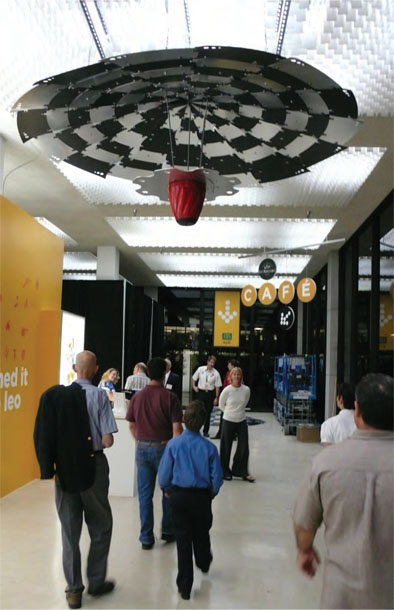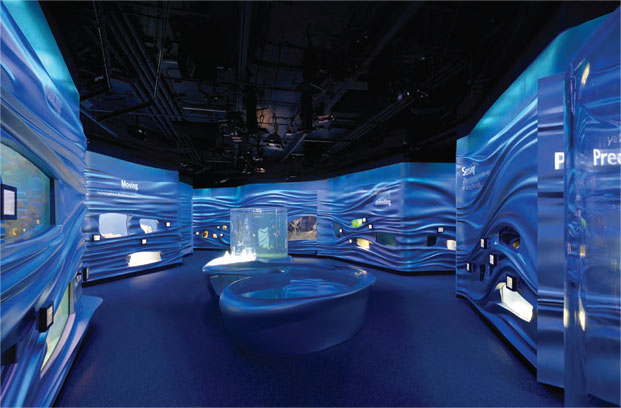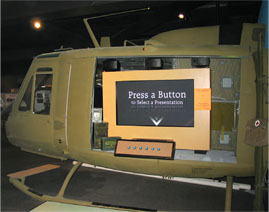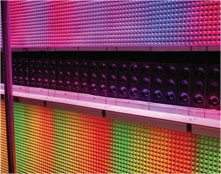Interactive To The People

Museums Get To Know Their Patrons All Over Again
In the midst of daily reports on the demise of the economy and assorted budget cuts, there have been scattered reports on the museums segment of our culture. The unifying theme to these hesitantly optimistic news items is the renewal and revamping of exhibits to welcome the modern era. While some institutions
LeonarDomes at the Body Worlds 3 exhibition late last year in the Leonardo art and science museum in Salt Lake City’s Library Square. Each nine-foot LeonarDome was handcrafted using laser-cut aluminum panels. are attracting cherished “field trip” attendance by designing exhibits to match K-12 curricula, others are reshaping the context in which they display artifacts.
The “people’s museum” is the new stated ideal, but museums have always been about people. They offer context and a rare opportunity to gain understanding in a social environment.
“The major goal for us in creating an exhibit is to get people talking to each other—if we accomplish nothing further it’s a win,” emphasized Tom Hennes of Thinc Designs, an exhibit design firm in New York, NY.
For Hennes and others who work in the museums space, audio, video, control, and networking technology are an increasingly vital element in encouraging interaction and learning. “There are things you can do with technology that you really can’t do any other way,” Hennes elaborated. “Whenever we design electronic exhibits, we try to give people a high degree of control over their experience so that they can go where their curiosity takes them. Then, wherever possible we try to situate it in a way that the interaction itself becomes a stimulus for conversation. Because typically we develop relationships with new things by talking about them.”
CONTACT ZONES
The multi-layered interaction that Hennes champions was recently incorporated by he and the Thinc Design team into a series of high-tech, high-touch exhibits for the newly renovated California Academy of Sciences in San Francisco, CA. When designing an interactive exhibit with a technological component, Thinc collaborates with AV designers to ensure that “the interaction is intuitive, playful, and invites the ease and comfort that goes beyond the monomaniacal focus on ‘I’ve gotta get the answer,’” Hennes said.

The Water Planet exhibit at the California Academy of Sciences is an immersive and interactive space which is also used as a 360-degree projection theater. This stunning display uses 10 projectiondesign F20 sx+ model projectors, which are projected on to silvery, sculptured walls. Thinc Design from New York designed the exhibit in collaboration with Urban A&O, with the projection, sound, and control systems installed by BBI of San Francisco. themselves are often quite easily obtained via the internet, and thus museums need to offer another angle—or several angles in order to attract visitors. That’s where AV designers pick up the thread, and they must do so gingerly. “Most museum directors and curators recognize that they have to have technology in their museums to tell their story to the customers, but to most of them, it’s a necessary evil,” noted Andrew Kidd, business development manager and technology consultant for Electrosonic.
A daily selection of the top stories for AV integrators, resellers and consultants. Sign up below.
Ultimately, Kidd elaborated, “the technology should be largely invisible. It should be completely secondary to the story. That’s not to say they don’t have to invest money in it, because they will likely have to.”
Needless to say, museum budgets are not boundless. “Usually we have to find a way to design around that and be clever, and yet at the same time, it’s a conundrum, because museums have got to compete with each other and with home gaming and flat panel display technology now. Their visitors are expecting an experience that would rival what they can do at home with a Wii or PlayStation. That’s tough. Part of the job of the design community is to make them aware of what they’re in for.”
STAND-OUT SOUND
This is not to say that museums are totally averse to exotic uses of technology. Electrosonic recently completed the implementation of a 308-channel Iosono sound system in the Peltz Theater at the Museum of Tolerance/Simon Wiesenthal Center in Los Angeles. In an effort to attract Hollywood previews and premieres, the Peltz Theater made the investment and is now one of only two venues in the U.S. to feature the pinpoint- accurate 3D aural surround experience enabled by this technology.

The Sullivan Brothers Iowa Veterans Museum offers re-enactments or interviews with veterans of each of several wars. SoundTube SM400i speakers and a RS100-li-II subwoofer were installed in a Huey helicopter exhibit in the Vietnam Voices of Veterans Theater. invisible. But here too museums are seeking more sculptural solutions to the aural dimension of exhibits. In anticipation of the huge crowds that would visit the touring Body Worlds exhibit at the close of 2008, The Leonardo museum in Salt Lake City commissioned a new sound-focusing product from David Wiener Ventures. The end-result was a nine-foot aluminum dome that is anything but invisible.
“It would have been easy to simply design a sound focusing product, or put regular speakers in the space, but the goal was to make it very sculptural,” explained David Wiener. “The museum asked us to create something and make it stand out. They wanted it to be a big deal.”
RECURRING REVENUE
Traveling exhibits such as Body Worlds have generated tremendous revenue for museums on several continents, but the profit potential isn’t limited to large-scale facilities. With the right technology and some good old-fashioned innovation, smaller, specialized museums can package their expertise and rent it out to other local, regional, or national museums. “This gives them an additional revenue stream,” observed Jeremy Scheinberg, chief operating officer for Alcorn McBride.

Electrosonic recently completed the implementation of a 308-channel Iosono sound system in the Peltz Theater at the Museum of Tolerance/Simon Wiesenthal Center in Los Angeles. only to your Smithsonians and your really high-end museums, but now, not only are guests expecting it, but the ability for museums to deliver it has increased,” Scheinberg said.
As institutions grow and change in order to attract new visitors and inspire local patrons to return, there is much opportunity for AV designers and integrators to help tell the story.
“One of the other aspects of museums that’s ill understood is the degree to which they can change the world around,” Hennes concluded. Considering the number of museum visitors every year—a 1999 study by Lake, Snell and Perry reported that American museums average approximately 865 million visits per year, or 2.3 million visits per day-Hennes elaborated, “That’s a lot of people. That’s a lot of impression. Museums are meeting places. They’re contact zones among different groups of people, communities, and among all kinds of different ideas. Technology, the web, and virtual presence, as well the physical human presence that these places represent is something we’re going to see amplified in some significant ways over the next decade—at least if I have anything to say about it.”
